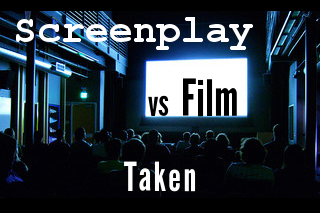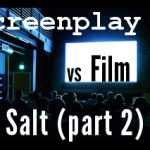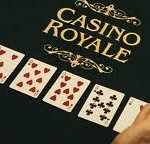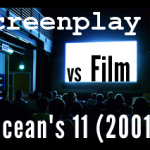Today’s Screenplay vs Film selection is Taken, the 2008 thriller starring Liam Neeson, and written by Luc Besson and Robert Mark Kamen. Luc Besson also directed the film. [UPDATE: thanks to Jon’s comment, I stand corrected. Pierre Morel directed Taken.]
The movie was made on a modest budget of $25 million, but grossed $125 million just in the United States alone. It was a major blockbuster success…that no one was expecting.
I’m not sure why the movie resonated with so many people, although I have a few ideas. Taken’s premise is not that original: “a former spy relies on his old skills to save his estranged daughter, who has been forced into the slave trade” (taken from IMDB).
Its hook is certainly not as original as the Bourne Identity (a spy wakes up with amnesia and must elude assassins sent by the agency who created him), to which Taken will inevitably be compared.
Taken is also not as high concept as Unknown, another action-thriller starring Liam and released in 2010, in which “a man awakens from a coma, only to discover that someone has taken on his identity and that no one, (not even his wife), believes him.” (This is also from IMDB.)
So if Taken wasn’t a blockbuster because of its premise…then why?
I’d argue it’s the execution where Taken really sparkled. It was not an original thriller, but it was a well-done one. It’s tightly honed and woven well. No fluff, no subplots. Its screenplay is a study in economy. If you find yourself adding too much extraneous stuff to your screenplay–whether scenes, characters, subplots, or just a sheer volume of too many words–then this is a movie and screenplay to study.
Taken outshines big-budget features because of its focus. Liam’s character has a clear goal–find his daughter and punish the people who abducted her–and he never loses sight of it.
Never underestimate the power of a clearly articulated goal which a character pursues with a single-minded tenacity.
It’s so fundamental to a good screenplay, so much a part of its “guts” that a lot of beginning screenwriters are liable to leave it in the dust as they explore more “sexy” screenwriting techniques.
In addition to focus, Taken also made sure that the audience maintained their emotional investment in Liam Neeson’s character as we’ll see in screenwriting tip #2. Taken is well-paced too, with a balance of action and quieter periods. The action itself is not over the top, full of gadgets and special effects, but stays true to the raw martial arts which made Bourne such a pioneer in the action movie genre.
In analyzing the success of Taken, I’d be remiss if I didn’t address the Neeson factor. Having him in the lead role was a definite bonus. He’s tall, slightly rough around the edges, but still sophisticated, making him appealing to both men and women.
You can’t control who plays the lead in your screenplay, but you can control the quality of execution of your script. Following from these screenwriting tips will help you do that. There are not that many differences between the screenplay I read and the movie released in theaters.
Some of the screenwriting tips I learned are from a few of those screenplay & film differences; some of them are based on elements in Taken’s screenplay that worked noticeably well.
There were a few extraneous scenes in the screenplay’s beginning which got cut from the movie. Studying those is a good way to identify redundancies in your own screenplay. That’s a subject for a later post, but for now, enjoy part I of these screenwriting tips from Taken.
Screenwriting Tip #1: Writing Transitions
I haven’t really written much about screenplay format, but even if you’re a beginning screenwriter, you probably know that using “CUT TO” in between scenes is outdated. A new slug implicitly conveys a cut, so it’s pretty much unnecessary.
But if you want to signal to a reader that you’re a real pro and not an amateur screenwriter, don’t just rely on starting a new scene with a new slug line. Instead, try to create smooth, cinematic transitions that make use of a unifying device (something visual or auditory).
These examples from Taken’s screenplay should give you an idea of what I mean:
Screenplay Example #1: The Card
Bryan nods, acknowledging her apology. Holds up the card.
BRYAN
Thank you.
DIVA
No. Mr. Mills, thank you.
She kisses him on the cheek, disappears into her bedroom.
Bryan stands there, alone in the huge suite, can’t help but feel things seem to be going his way. He looks at the card.
CLOSE UP
On the card.
INT. COFFEE SHOP – DAY
Bryan sits, turning the card over in his hand, feeling very pleased, excited at what he has to offer. He looks up to…
Screenplay Example #2: The Hand
Bryan is left looking at the paper, and the Diva’s card in his hand.
CLOSE UP
A hand knocks on a door.
* In spec screenplay, you’re better off staying away from ALL camera directions. Instead of using “CLOSE UP,” you could put “HAND” in all caps like this:
A HAND knocks on a door.
or like this:
A
HAND
knocks on the door.
Either way signals you want a tight shot without the camera direction which annoys so many readers.
Screenplay Example #3: The Plane
EXT. LAX RUNWAY – DAY
The Air France flight lifts off.
EXT. PARIS AIRPORT – DAY
Bustling with arrivals of flights from all over the world.
Amanda and Kim come rushing out of customs…
But remember, like strong perfume, a little goes a long way. Don’t use unifying devices in every transition because your screenplay will come across as two “cutesy.”
Screenwriting Tip #2: Don’t kill the dog
This screenwriting is so named because it’s the corollary to Blake Snyder’s rule of Save the Cat, which basically states, “write a scene which gets the audience “in sync” with the main character.” Saving a cat is a sweet gesture which can get the audience “sync” with your hero.
My rule, “don’t the kill the dog,” is similar in concept. If you want to make your hero the good guy, then he can’t do anything glaringly mean or cruel. He can be lazy, vulgar, slovenly, childish, cold (emotionally)…but never cruel. If he beats someone up in his pursuit of justice, that person has to have it coming to them. Otherwise, he won’t remain the hero in your audience’s eyes–and they will not be in sync with him.
In the screenplay version of Taken, Besson and Kamen basically had Liam Neeson’s character, Bryan Mills, take out a doorman.
EXT. TWENTY RUE DE LA POMPE – MORNING
CLOSE ON
A hand rings the bell. The door opens.
CONCIERGE
(curt)
Yes?
BRYAN
(French)
The Morels please.
CONCIERGE
The Morels are away.
Officious and cold, as only a French concierge can be.
BRYAN
Yes I know. In Spain. Their cousin and my daughter are staying in the apartment while they are away. You’ve seen them, yes? Two American girls?
He holds up the picture he took at LAX of Kim and Amanda mugging for the camera.
CONCIERGE
No. I didn’t. Excuse me.
He closes the door. Bryan rings again. Again the concierge opens.
CONCIERGE
If you continue I will be obliged to call the police.
Before the words are out of his mouth, Bryan knocks him out with a well placed knuckle blow to his neck. He catches the falling body, stepping through the open door.
Bryan didn’t kill the concierge, but he did render him unconscious — and unnecessarily so. It was the equivalent of killing a dog, and even though the audience sympathizes with Bryan and wants him to go to the ends of the earth to find his daughter…they don’t necessarily want to see innocent bystanders become collateral damage.
By the time they shot the movie, it seems Besson figured this out because in the film, Bryan doesn’t kill the doorman. Instead, he tells a woman leaving the apartment building that he’s there to visit the family in the 5th floor apartment, and she lets him right in. It was a much better screenwriting choice, although it isn’t cinematic and doesn’t contain one iota of action, because the audience could remain emotionally invested in Bryan’s quest, which was essential to Taken’s success.
Salt is another thriller which employed the rule of “don’t kill the dog,” as you can see in screenwriting tip #4 in 11 Screenwriting Tips from Salt. One movie which ignored that rule–to its blockbuster peril–was Deja Vu. It’s a great screenplay written by Terry Rossio and Bill Marsilii. It was so terrific that it was produced by Jerry Bruckheimer and directed by Tony Scott.
To the dismay of the screenwriters, the director had Denzel Washington’s character engage in a high-speed car chase which causes the killing of innocent bystanders. As Bill Marsilii succinctly put it, “As the action stands now, Doug [Denzel’s character] is killing people, pure and simple. Passenger cars are flipping over into oncoming traffic and getting smashed to bits. Please, I love action, but not a hero committing vehicular homicide.”
Despite this, I still think Deja Vu is a great movie, (and it’s definitely a candidate for a future Screenplay vs Film post), but I have to admit, I did disengage from Denzel when he was mowing down innocent civilians. It seemed way out of character, not to mention it’s uncharacteristic of any hero. Now, anti-heroes…that’s a different subject, and this rule doesn’t necessarily apply.
Screenwriting Tip #3: A troublesome translator is better than an accommodating one
This screenwriting tip basically is an example of a major tenet of screenplay writing: conflict is key. You need conflict in every scene. That doesn’t mean that your characters have to be yelling at each other. Think of it like this: at least one thing, whether big or small, is not going your character’s way.
In the movie and screenplay versions of Taken, Bryan hires a translator to tell him what the Albanian thugs involved in a prostitution ring are saying. In less skilled hands, the translator would have just conveyed the information to Bryan.
But Besson and Kamen are old pros, so they wrote the scene like this:
BRYAN
Translate.
Gregor begins to translate.
GREGOR
They are talking about you.
BRYAN
What about me?
GREGOR
They are saying not nice things.
BRYAN
Be specific.
GREGOR
They are saying, excuse me, what an a****** you are.
(beat)
Please if you can explain why we are doing…
BRYAN
Just translate.
GREGOR
…the other is suggesting something his grandmother used to give him for the same thing.
(beat)
Do you really want to hear all this?
BRYAN
Every word.
When you’re writing your own screenplay, think about this screenwriting tip. Even if your hero has hired someone to do something, that doesn’t mean that the employee has to do it the way your hero envisioned.
In Taken, Bryan just wants his translator to translate. But the translator wants to know the purpose of the translation. Because Bryan doesn’t want to reveal this, he’s at odds with the translator, yielding a nice bit of conflict to what could have been a very static scene.
Final thoughts
This is just part I of the screenwriting tips I learned by studying Taken’s screenplay and film. Here is part 2.
A lot of the differences between Taken’s screenplay and the movie released in theaters had to do with establishing Bryan’s character traits and backstory. You’ll want to read this post, if you have difficulty setting up exactly who your hero is.
Watching a blank screen (with modifications) by Kenneth Lu





















Comments on this entry are closed.
Luc Besson did not direct Taken.
Director: Pierre Morel
http://www.imdb.com/title/tt0936501/
Hi Jon,
Thanks for visiting Scribe Meets World. You are absolutely right – Luc Besson did not direct Taken. Since he has written and directed many of his screenplays (like Leon: The Professional and The Fifth Element), I assumed he had directed Taken as well…without checking out the IMDB credit listing carefully. Good catch!
Thanks for the interesting read! I’m a film student and I couldn’t agree with you more! Do You happen to know where I could obtain a copy of the screenplay for educational purposes?
Hey, very interesting read. Was wondering if there was a link to read the Taken screenplay?
Much appreciated
I agree with you that Taken doesn’t waste a word, skillful and taut thriller.
One of my other favorite masterpiece scripts: Oliver Stone’s PLATOON.
Online one can access an earlier draft of The Fighter script PDF, and on IMDB, the draft done by genius David O’Russel. Highly recommended for any screenwriter or filmmaker.